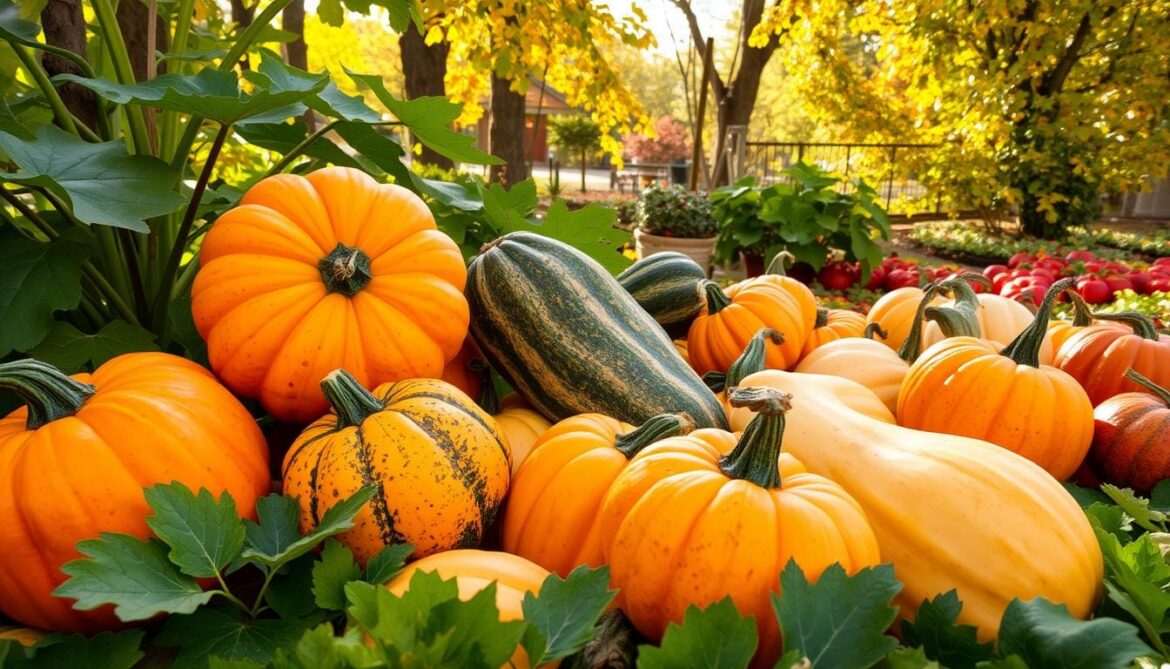Every autumn, our garden turns into a colorful scene of pumpkins and winter squash. Each squash has a story of growth and care. Harvesting winter squash is more than a task—it’s a way to connect with nature’s cycles.
Knowing when to pick winter squash is key. It can make your harvest rich in flavor or a letdown. Understanding when to pick and before frost hits is important.
This guide will show you how to harvest winter squash right. We’ll cover how to spot when it’s ready and how to keep it fresh. You’ll learn how to make your squash harvest amazing.
Key Takeaways
- Harvest winter squash before temperatures drop below 45°F
- Look for deep, rich color and hard rinds as maturity indicators
- Different squash varieties have unique storage lifespans
- Proper curing is critical for long-term winter storage
- Temperature and humidity are vital for keeping squash fresh
Understanding Winter Squash Varieties
Winter squash is a diverse and nutritious group of vegetables. They add rich flavors and essential nutrients to our meals. Each type has its own shape, size, and color, making them unique in the kitchen.
Winter squash falls into four main families: pepo, maxima, moschata, and mixa. Each family grows differently and has its own storage needs. This affects how we harvest and keep them fresh.
Popular Winter Squash Types
Here are some favorite winter squash varieties:
- Butternut squash: Known for its sweet, nutty flavor
- Acorn squash: Recognized by its distinctive ridged shape
- Spaghetti squash: Unique for its stringy, pasta-like texture
- Pumpkin: A versatile squash with numerous culinary applications
Winter vs Summer Squash
Winter squash and summer squash differ in maturity and storage. Winter squash, like butternut and acorn, have hard rinds and can last months. Summer squash, with softer skins, has a shorter shelf life.
| Variety | Harvest Time | Storage Duration |
|---|---|---|
| Butternut Squash | Late Summer | 4-8 months |
| Acorn Squash | Early Fall | 1-3 months |
| Spaghetti Squash | Late Summer | 2-3 months |
| Pumpkin | Early Fall | 3-6 months |
Nutritional Benefits
Winter squash is a nutritional powerhouse. They are full of vitamins A and C, fiber, and antioxidants. Butternut and acorn squash are top choices for their high nutrient value, making them great for a healthy diet.
“Winter squash isn’t just food, it’s a nutritional powerhouse waiting to be discovered in your kitchen.” – Culinary Nutrition Expert
Signs That Indicate It’s Time to Harvest
Knowing when to pick squash is key. You need to watch for signs that your winter squash is ready. Each type of squash has its own way of showing it’s time to harvest.
Winter squash gives you clues to know when to pick it. These clues help gardeners get the best quality and longest storage life for their squash.
Color Transformation Indicators
Color changes are a top sign of squash maturity. Here are the main color signs:
- Young squash are pale green with colored streaks
- Mature squash have deep, solid colors
- Butternut squash turns from pale green to deep tan
- Dark green stripes near the stem fade
Rind Hardness Assessment
The squash rind’s hardness is very important. A mature squash will show these signs:
- The rind is hard to puncture with a fingernail
- The surface is tough and feels resilient
- The skin looks dull, not shiny
“A squash’s skin tells a story of its maturity – learn to read its subtle language.”
Stem Condition Evaluation
The stem is another key indicator. Look for these signs when picking squash:
- The stem becomes woody and dries out
- The stem should be about 1 inch long after picking
- The stem turns from green to brown
By knowing these signs, gardeners can pick their winter squash at the best time. This ensures the squash tastes great and lasts longer.
Ideal Timing for Harvesting
Timing is key for a successful winter squash harvest. Our guide will show you when to pick for the best taste and shelf life.
Regional Climate Considerations
Winter squash needs careful planning based on your local weather. It grows for 95 to 120 days, with big differences by region. Gardeners must watch temperature milestones for the best harvest.
- Monitor daily temperatures closely
- Track frost predictions in your area
- Understand your specific microclimate
Timing Relative to First Frost
The key time for harvesting winter squash is before frost. Squash can’t handle temperatures below 45 degrees Fahrenheit. So, timing is everything for a good harvest.
| Temperature Range | Squash Response |
|---|---|
| 35-45°F | Brief exposure possible with recovery |
| Below 35°F | Potential crop damage |
| 28°F for 2+ hours | Severe frost risk |
“Timing is everything in the squash harvest – know your local climate, and you’ll maximize your crop’s potential.
Finish harvesting winter squash before the first frost. A light frost can help by making leaves fall off. But, too much cold can harm the crop.
Remember, squash varieties grow at different speeds. Butternut squash turns from light green to golden-tan when it’s ready.
Tools and Equipment Needed for Harvesting
Getting ready to pick squash needs the right tools and safety gear. Our guide will show you what you need for a successful harvest.
Essential Gardening Tools for Squash Harvesting
For winter squash harvesting, you’ll need specific tools. This ensures a clean and efficient harvest. Here are the must-haves:
- Sharp pruning shears or garden scissors
- Sturdy harvest basket or large container
- Garden gloves with good grip
- Knee pad or garden cushion
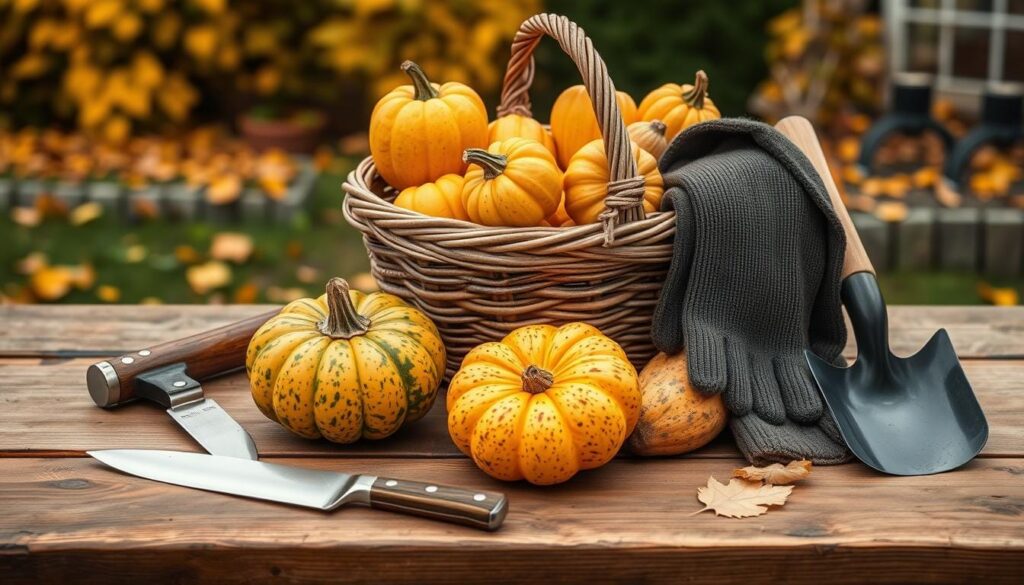
The most important tool is sharp pruning shears. Cut the fruit carefully from the vine, leaving approximately 2-3 inches of stem attached to each squash. This helps prevent rot and keeps the squash fresh longer.
Safety Gear for Protected Harvesting
Keeping yourself safe during harvest is as important as protecting the squash. Here are some safety tips:
| Safety Item | Purpose | Recommended Type |
|---|---|---|
| Gardening Gloves | Protect hands from prickly vines | Thick canvas or leather gloves |
| Closed-toe Shoes | Prevent foot injuries | Sturdy work boots or hiking shoes |
| Long-sleeve Shirt | Shield skin from scratches | Light, breathable fabric |
“Always prioritize personal safety while enjoying the rewards of your winter squash harvest.”
Investing in the right tools and safety gear makes harvesting enjoyable and productive. Handle your squash gently and store them well to keep them fresh longer.
Harvesting Techniques for Optimal Quality
Squash picking needs precision and care for the best winter squash harvest. Our guide will show you the key techniques to protect your crop from damage during harvest.
When you harvest winter squash, gentle handling is key. Winter squash are delicate, even though they look tough. A single drop or rough move can ruin the whole crop’s quality and how long it can be stored.
Proper Cutting Methods
To successfully harvest winter squash, you’ll need sharp, clean pruning shears or a knife. Follow these important steps:
- Use sterilized cutting tools to prevent disease transmission
- Cut the squash with 3-5 inches of stem attached
- Make clean, precise cuts near the main vine
- Avoid twisting or pulling the squash
Minimizing Damage to the Fruit
Protecting your winter squash during harvest is critical. Here are expert tips to prevent bruising and keep quality high:
| Harvesting Practice | Impact on Squash Quality |
|---|---|
| Gentle handling | Prevents bruising and extends storage life |
| Avoid dropping | Reduces risk of internal damage |
| Use padded containers | Protects squash during transportation |
Pro tip: Always set winter squash down gently and never stack heavy squashes on top of each other.
By using these careful harvesting techniques, you’ll get the best quality and longest storage life for your winter squash crop.
Cleaning and Preparing Squash Post-Harvest
After you pick your winter squash, cleaning it right is key for keeping it fresh. The right steps can make your squash last longer.
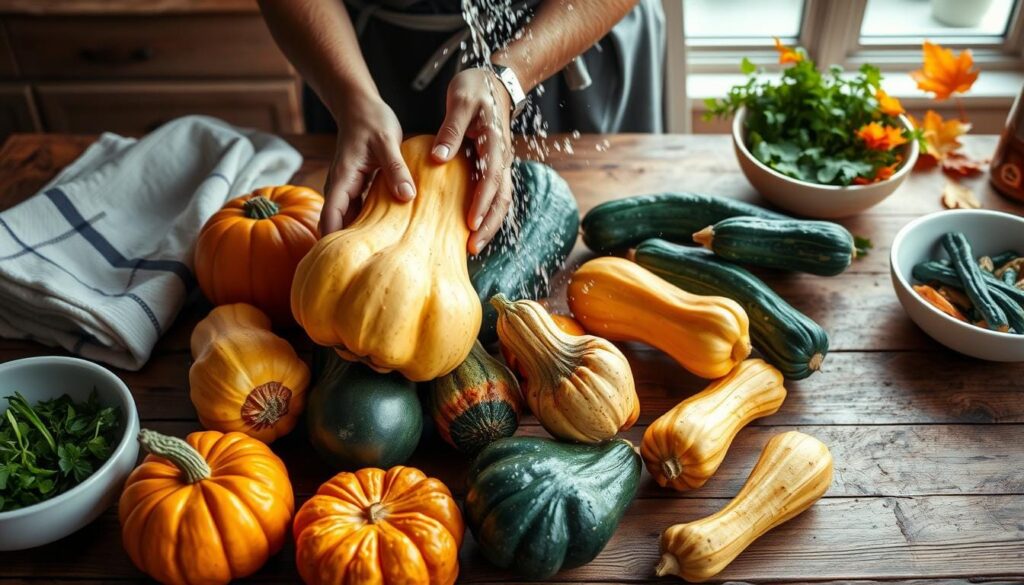
Gentle Cleaning Techniques
- Use a soft, dry cloth to remove dirt
- Avoid water to prevent mold
- Wipe gently to keep the protective layer
Detailed Inspection Process
Check each squash for any problems that could affect storage. Look for these important signs:
| Condition | Action |
|---|---|
| Dark spots | Use immediately |
| Intact stem | Good for long-term storage |
| Broken stem | Prioritize for quick use |
Cleaning Solution Recommendations
For extra protection, try a gentle cleaning solution:
A mix of 1 part vinegar to 4 parts water can clean without harming the skin.
Proper cleaning is just the start to keeping your squash fresh. Handling it carefully and storing it right will help it last longer.
- Cure squash for 10-14 days at 80-85°F
- Store at 50-55°F with 50-70% humidity
- Inspect weekly for any signs of deterioration
Storing Winter Squash for Longevity
Storing winter squash right is an art. Our guide will show you how to keep your squash fresh and tasty all winter long.
First, you need to know the best storage conditions. Each type of winter squash has its own needs. But, they all share some basic rules.
Ideal Storage Environment
To store squash perfectly, you need the right temperature and humidity. Here’s what works best:
- Temperature range: 50-55°F
- Humidity: 50-70%
- Well-ventilated area
Best Practices for Long-Term Storage
To keep your squash fresh for a long time, follow these tips:
- Cure squash for 7-10 days after harvesting
- Inspect for any damage before storage
- Store in a single layer with space between fruits
- Check stored squash regularly for signs of decay
“The key to successful winter storage is creating an environment that mimics the squash’s natural preservation conditions.”
Each squash type lasts differently. Butternut squash can last 3-6 months. Acorn squash might only last 1-2 months. But Hubbard squash can last up to 27 weeks with the right care.
Don’t store squash in cold, damp places. The best spot is a cool, dry pantry or a special storage area. It should stay at a steady temperature and humidity.
Common Diseases and Pests to Watch For
Preserving winter squash means keeping an eye out for threats. Pests and diseases can ruin your hard work. Spotting them early is key to keeping your squash safe.
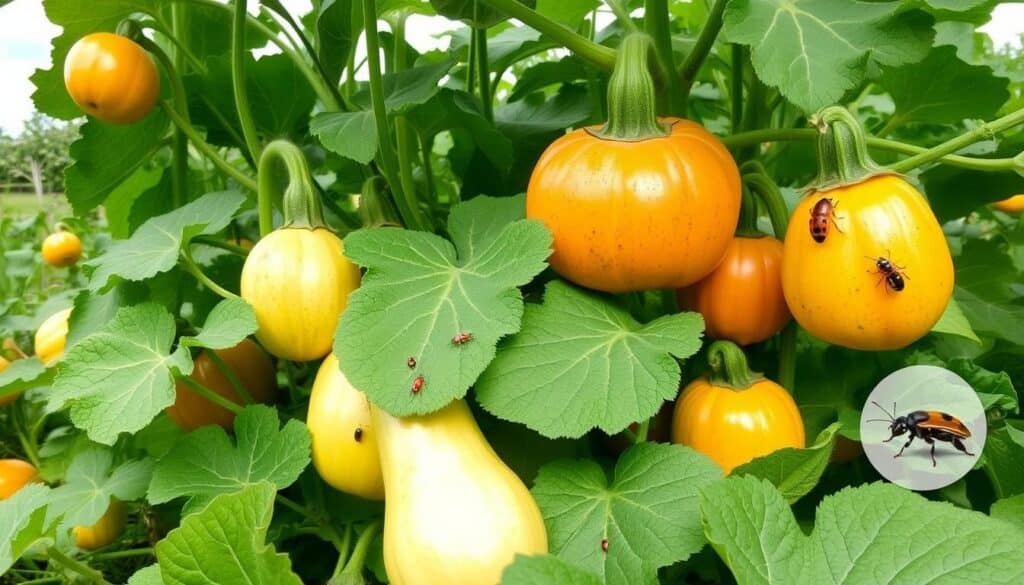
Identifying Common Squash Pests
Our gardens face many challenges from insects. Key pests include:
- Cucumber beetles
- Squash vine borers
- Aphids
- Squash bugs
- Whiteflies
Squash bugs are a big problem. They lay 10-20 eggs on leaves. These eggs hatch quickly, multiplying fast and threatening your squash.
Managing Disease Risks
“Prevention is always better than cure in squash preservation.”
Managing diseases requires a few steps:
- Choose virus-resistant squash
- Rotate crops
- Remove debris quickly
- Keep fertilization consistent
Powdery mildew is a common fungal issue. We suggest using organic solutions like:
- Milk spray (10-50% concentration)
- Baking soda mix
- Compost tea
Our methods focus on early detection and managing pests. Regular checks can stop problems before they start.
Culinary Uses for Winter Squash
Winter squash makes any meal special. It turns simple dishes into something amazing. From creamy butternut squash soups to roasted acorn squash sides, these veggies add nutrition and flavor.
Popular Winter Squash Recipes
Our top winter squash recipes highlight each type’s unique taste:
- Butternut Squash Soup: A creamy, warming dish perfect for cold nights
- Roasted Spaghetti Squash with Herbs: A low-carb pasta alternative
- Pumpkin Muffins: A delightful breakfast or snack option
- Stuffed Acorn Squash: A hearty vegetarian main course
Nutritional Cooking Tips
Here are some tips for cooking winter squash:
| Squash Type | Cooking Method | Nutritional Benefit | Cooking Time |
|---|---|---|---|
| Butternut Squash | Roasting | High in Potassium | 30-45 minutes at 375°F |
| Spaghetti Squash | Steaming | Low Calorie | 25-35 minutes |
| Acorn Squash | Microwaving | Rich in Vitamin C | 10 minutes on high |
| Pumpkin | Instant Pot | High Vitamin A | 15-20 minutes |
Pro tip: Preserve nutrients by using minimal water during cooking and avoiding overcooking.
Our winter squash recipes aim to boost flavor and nutrition. Try different cooking methods to find your favorite!
Preserving Winter Squash
Preserving winter squash is key to enjoying your harvest all winter. We’ll show you the best ways to freeze and can your squash. This keeps its quality and taste.
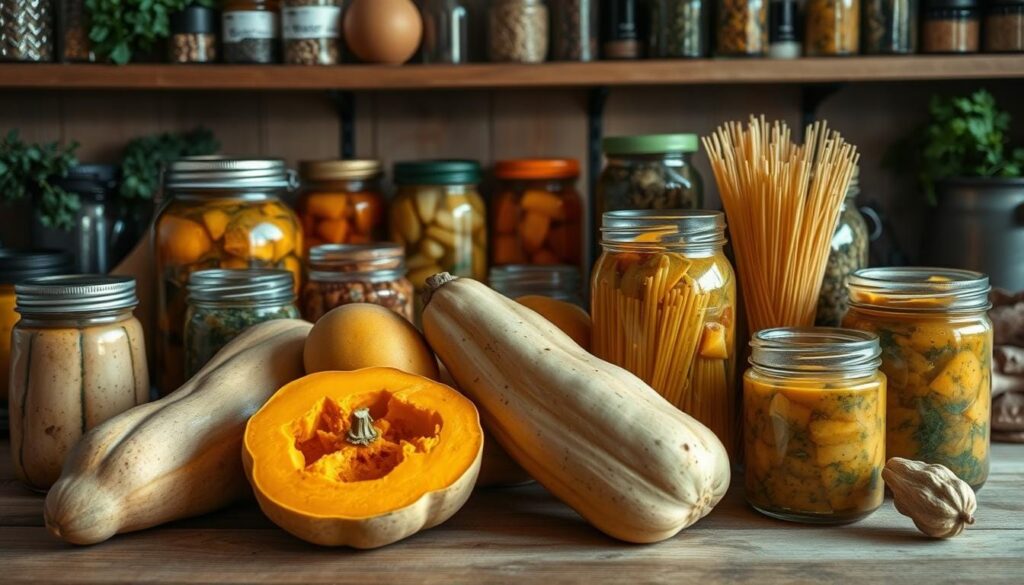
Keeping your squash fresh is important for winter enjoyment. There are many ways to store your squash. This helps you get the most from your harvest.
Freezing Techniques
Freezing is the best way to keep winter squash. Here’s how to freeze it right:
- Cut squash into 1-inch cubes
- Blanch cubes in boiling water for 2 minutes
- Cool quickly in ice water
- Package in airtight freezer containers
- Label with date of freezing
Pro tip: Frozen winter squash can last up to 1 year when properly prepared.
Canning Methods
Canning winter squash needs special care because it’s low in acid. Pressure canning is the only safe way to can it.
| Canning Container | Processing Time | Pressure Requirements |
|---|---|---|
| Pints | 55 minutes | 11 pounds (dial gauge) 15 pounds (weighted-gauge) |
| Quarts | 90 minutes | 11 pounds (dial gauge) 15 pounds (weighted-gauge) |
“Safety first: Always follow precise canning guidelines to prevent possible health risks.” – USDA Food Preservation Guidelines
Storing squash for winter needs careful attention. Keep it in a cool, humid place. With these tips, you’ll enjoy your squash all winter.
Troubleshooting: What to Do if Your Squash Isn’t Ripening
During squash season, gardeners face issues with winter squash not ripening. Knowing the causes and solutions can save your squash crop.
Common Ripening Challenges
Winter squash varieties ripen at different rates. Several factors can affect ripening:
- Insufficient sunlight exposure
- Nutrient deficiencies in soil
- Temperature fluctuations
- Pest or disease damage
Ripening Solutions for Different Squash Varieties
Each squash variety has its own ripening needs. Cucurbita moschata types like butternut ripen better off the vine. On the other hand, Cucurbita pepo types, like acorn squash, do best on the vine.
| Squash Variety | Ripening Potencial | Recommended Action |
|---|---|---|
| Butternut | High | Can ripen post-harvest with some color |
| Acorn Squash | Low | Best ripened on the vine |
| Tromboncino | Moderate | Partial ripening possible |
Strategies for Maximizing Ripeness
When frost hits before squash is fully ripe, try these tips:
- Harvest squash with some initial coloration
- Store in a warm, sunny location
- Remove unripe fruits to redirect plant energy
- Check for soft spots and use as immature squash
“Not all unripe squash are lost – many can be transformed into delicious dishes with the right preparation.”
By grasping these ripening tips, gardeners can get the most from their winter squash harvest, even when faced with challenges.
Sustainable Practices in Squash Harvesting
Sustainable squash picking means taking care of the whole garden. We use methods that help the environment and grow more squash. Our goal is to make gardens healthy and strong, supporting both crops and nature.
Crop rotation is key to growing squash well. We switch up what we plant to keep pests away and keep the soil rich. Dr. Brent Loy says keeping plants healthy is vital for growing great squash.
Organic Pest Control Methods
We use natural ways to fight pests without chemicals. Planting herbs like basil and marigolds helps keep bugs away. We also attract good bugs like ladybugs and lacewings to keep the garden balanced.
Crop Rotation Benefits
Crop rotation helps squash grow better. It makes the soil better, adds nutrients, and fights diseases. Our way of farming keeps the soil healthy and squash crops coming.
